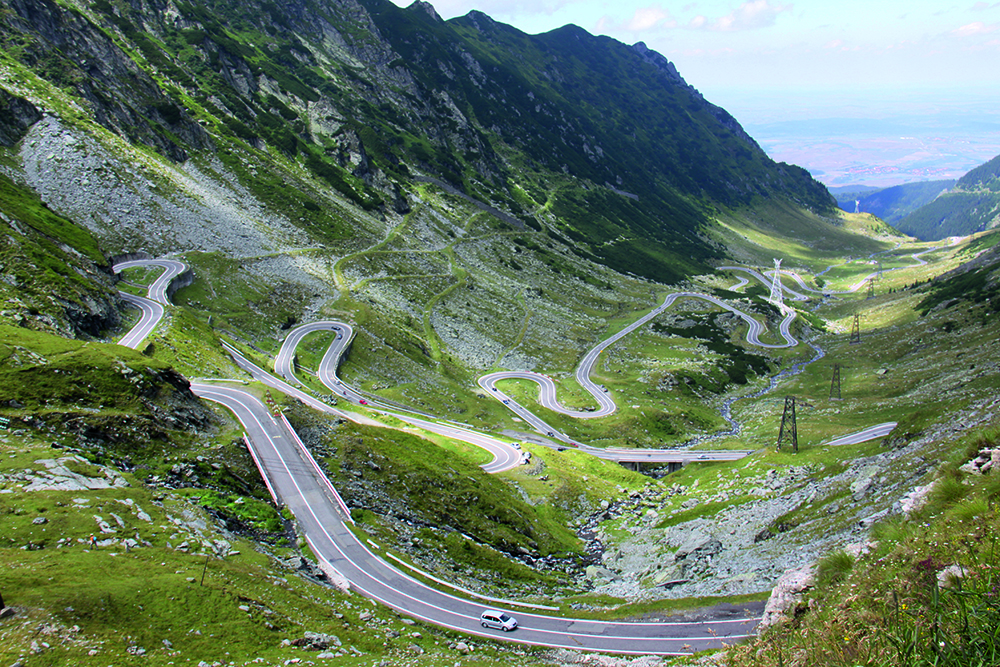Motorhome travel: Rural Romania
We first visited Romania about 11 years ago and fell in love with its magnificent mountain scenery, sleepy little villages, awe-inspiring towns and virtually no motorised traffic, just horses and carts. People were out in the fields, working the land by hand with wooden hoes and scythes. We felt we had passed through a time warp!
Since that first visit we have driven through Romania a number of times while en route to more distant places. Over these years we’ve seen the country developing rapidly. On our first visit, Romania was challenging; now there is good tourist infrastructure. New highways link the main towns, although care still needs to be taken when driving in more rural areas.

Previously we had often had to stop at B&Bs and ask if we could park there for the night or look out for home-made signs for camping. On this trip we found many excellent campsites that made us very welcome. Many of these sites even had WiFi. We spent our first night on the car park by the Hodos-Bodrog Monastery near Arad, a city full of impressive Habsburg-era buildings – but with a parking problem. Even small motorhomes like ours could not find a central spot.
The monastery (and there are many of them) is one of the oldest in Romania. The present complex was built some 700 years ago to replace an earlier monastery. It is a beautiful and peaceful place surrounded by protected parkland. However, for those of us who were legitimately staying there overnight on its car park, the peace was shattered when evening prayers (which we couldn’t understand) were relayed by loudspeaker across the entire complex! We just hoped that morning prayers did not start too early.
There's more to Transylvania than Dracula!
Transylvania is known mainly for its links to Dracula, made famous by Bram Stoker’s novel (and Hollywood), yet there is so much more than this to draw the visitor to the area. Dramatic mountain scenery, diverse town architecture and appealing small villages with their fortified churches all reflect the chequered history and turbulent past of the region.
The Unesco-listed fortified church in the tiny village of Calnic is not an easy place to reach if, like us, you entered by the wrong road! Single track roads with no passing places for several miles are not recommended, so make sure you stick to the signed route off the main road. The church was worth the effort, though. It was built in the thirteenth century and is still enclosed by one-and-a-half rings of high walls, with two defensive towers.
We also revisited the fortified church at Biertan. Here, three tiers of 11m (36ft) defensive walls, towers and gates protect the impressive fifteenth century church, which dominates this charming village. Nowadays cars line its streets instead of horses and carts. We decided to then head south, crossing the mountains by means of the Transalpina highway which also incorporates the King’s Road, then we would return over the spectacular Transfagarasan highway back into central Romania.
As we drove higher the scenery became more alpine and vast vistas opened up – that is, until the mist rolled in making it too dangerous to continue to the road’s highest point at 2,145m (7,037ft). We spent a cold night parked safely in a layby. By morning the mist had lifted and we headed over the pass and into the valley, where we camped for the night before tackling the Transfagarasan highway.
The road to the Transfagarasan was a feast of delights and the many hairpin bends up the side of the valley made sure the driver and navigator were kept on their toes. We passed the ruins of Poenari Castle brooding over the deep valley. This is supposedly the real Dracula Castle. It was built around 1460 to guard the entrance of the valley. Unfortunately, a landslide in 1888 caused most of what remained of the castle to collapse into the river below.
But who was the Dracula of legend? Vlad Tepes (or Vlad the Impaler as he was better known), was born around 1431 and was the second son of Vlad Dracul, ruler of Wallachia, (now a district in Central Romania). As the young Vlad grew up he became a ruthless soldier who used torture on his captives. It is this that inspired the Dracula legend.
Tackling the Transfagarasan highway in a motorhome
The Transfagarasan highway is an extraordinary feat of engineering. It was the creation of Romania’s communist-era leader, Nicolae Ceausescu, who, it is rumoured, ordered the road’s construction so as to surpass the Transalpina highway. After driving the series of tight hairpin bends that, from above, look like tangled spaghetti, John was in need of some real rest, so we headed to the lovely De Oude Wilg campsite in the tiny village of Cârta near the northern start point of the Transfagarasan highway.
It was not our first visit to this tranquil little gem of a site where, on arrival, you are offered a delicious tipple of the Dutch owner’s home-made liqueur. This time it was raspberry liqueur.
Next stop was Sighisoara but, en route, we made a stop to admire Fagaras’ fortress that was built on the site of the citadel which had been destroyed by none other than Vlad the Impaler. The old town of Sighisoara is the birthplace of Vlad and now a Unesco World Heritage Site. It’s a maze of battlements, picturesque towers, cobbled streets and incredible history, having changed hands many times over the centuries. The historic centre dates back to the twelfth century. The house where Dracula was born lies in the heart of the old town.
Having failed to see the ruins of Poenari Castle, we were determined to revisit the castle in Bran. This castle is incorrectly called Dracula’s Castle, but the link is tenuous. At least there is a decent campsite nearby so we could walk to it. The castle, perched on a hill above the rather touristy village of Bran, at least looks a little ‘vampirish.’ Today the castle, following restoration, looks much as it would have done at the time Queen Marie of Romania (a granddaughter of Queen Victoria) lived there.
Not far from Bran Castle is striking Peles Castle, set in a park landscaped in the English style. This castle was built to resemble a Bavarian Schloss, but this theme is only skin (rather, brick) deep as all 160 rooms are richly furnished in many different styles. Be warned, the castle gets very busy and parking nearby can be a problem.
Visiting monasteries in Romania
Our drive north took us through the wild, narrow Bicaz Gorge, which is as spectacular as it gets. Sheer limestone cliffs, a bubbling river and the road all vie for space. The area around Suceava in the north of Romania is famed for its painted monasteries. These tranquil Orthodox complexes, mainly founded in the fifteenth or sixteenth centuries, have the outer walls of the church covered with vibrant paintings.
A scenic road cresting at the Ciumarna Pass, with its outstanding views, led us to the smaller and lesser-visited monastic complex at Moldovita. This was founded in 1532 with its frescoes dating from a few years later. Here it was the fresco depicting The Siege of Constantinople that stood out. That night we stayed at the excellent Dutch-owned campsite at Fundu Moldovei and it was here that we were able to confirm that the road over the beautiful Prislop Pass was, indeed, in a very poor condition so best avoided. So it was the long way round for us.
At our next destination we stayed on the dedicated overnight motorhome area by the logging train station in Viseu de Sus. Next morning we boarded the steam train that took us up the picturesque Vaser valley towards the Ukrainian border. The line was built to carry lumberjacks to their camps and it’s still a working line, but visitors now outnumber workers.
En route to our final destination we made a short stop to view the Barsana Monastic complex, which has now been renovated. Nearby were a number of elaborate wooden churches characterised by their magnificent Gothic spires so typical of the Maramures area of Romania. The quirkily named Merry Cemetery at Sapãnta was our final stop. Here are beautifully carved and brightly coloured wooden headstones. Each one depicts portraits of and scenes from the life of the deceased. The inscriptions are often witty limericks such as ‘….who sought money to amass, could not death escape, alas’ or ‘Here lies my mother-in-law so do not wake her up or she will come back and bite my head off.’ The whole cemetery is like a book about the lives (and deaths) of the villagers.
I’m sure that we will return to Romania but, next time, will there still be storks’ nests on poles or rooftops? Will the horse and cart mode of transport have completely died out? Will potholed rural roads only be a distant memory? Only time will tell.
For more UK and abroad motorhome travel inspiration, click here.








.jpg)


Recent Updates
Engine management lights: all you need to know
What is the engine management light? What does it mean, and what do I have to do? ...
Motorhome air suspension: all you need to know
Motorhomes are heavy and the additional weight of equipment and height of the bodywork can increase the loads ...
Motorhome WiFi: how to get better motorhome internet
Staying connected on the move is more and more essential, so relying on campsite WiFi isn't an option – here ...
A class of their own - our guide to A-class motorhomes
Thinking of trading up to an A-class, or even going straight to the top of the motorhome tree? We guide you ...
Explore overseas on a motorhome dream tour
Enjoy exotic travel in a campervan or motorhome by hiring, swapping with someone else or exporting your ...
Motorhome water systems: everything you need to know
On-board water is an important part of every motorhome – here’s everything you need to know ...
Campervanning in Europe: what you need to know
Whether you're planning a leisurely drive through the French countryside, navigating bustling city streets in ...
Campervan security: all you need to know
With thefts on the increase, it’s important to know how to keep your campervan secure and prevent campervan ...
Campervan furniture: everything you need to know
Our campervan experts guide you through all the essentials for your campervan, including tables, chairs, ...
Campervan finance: how to fund your purchase
Here we look at the different types of campervan finance available, to help you decide what’s the best option ...
Other Articles
Britain’s best used motorhomes
Want a great motorhome without paying the premium for a new one? Here's a guide to the best you can get in the pre-owned market for each layout, ...
Which motorhome? Choosing the perfect motorhome for you
Choosing a motorhome or campervan is one of the biggest buying decisions you’ll ever make, so it's important ...
Campervan washroom essentials: stay fresh on the road
Our guide will take you through the campervan washroom essentials you'll need so you're well-prepared for ...
Dogs in campervans: all you need to know
Follow our advice and your dog will enjoy campervanning as much as you do ...
Electric campervans: all you need to know
Our guide will take you through everything you need to know about electric campervans and what the future ...
Motorhome electrics: a complete guide to your motorhome electrical set-up
Motorhome electrics can dramatically enhance the convenience and comfort of your vehicle – but they can be ...
Lighting for campervans: all you need to know
We guide you through all the lighting options available for you and your campervan, including interior ...
Electric bikes for motorhomes: our ultimate guide
Read our comprehensive guide to electric bikes for motorhome owners, helping you add electric power to your ...
Our guide to 'cheap' motorhomes in 2024
If you're on the hunt for an affordable new motorhome, this is the best place to start – we've rounded up a ...
Campervans in winter: all you need to know
Here's your guide to preparing your campervan for the colder months, whether you will be using it or putting ...